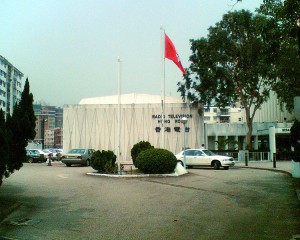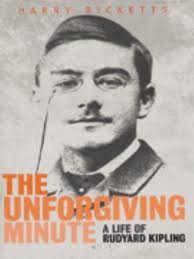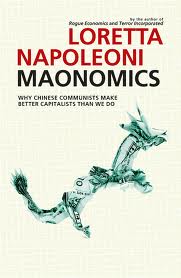Posted: March 3rd, 2013 | No Comments »
I’ve gone about old gates on this blog before (I know, it’s all a bit obscure). Anyway, I was up at RTHK in Hong Kong the other day on The Morning Brew with Phil Wealan talking Midnight in Peking, Badlands and all that. I love the RTHK Broadcasting House (廣æ’大廈) building on Broadcast Drive in Kowloon Tong – it has a real 1960s feel on technology and broadcasting. RTHK moved into the building in 1969

Of course over the years the building has changed – actually I think not so much inside – still today it has the feel of the interior of the old Broadcasting House on Portland Place, now superseded by the new Broadcasting House round the corner. And so to get back to gates – Interesting to me is that the entrance appears to have moved since the start – obviously security concerns and all that – but, as these pictures poorly indicate because they’re hard to snap – it does appear there were some nice designed gates that originally led into the complex and that are now all blocked up.


Posted: March 2nd, 2013 | No Comments »
Of course, it goes without saying, this book caught my eye – The Rice Paddy Navy: US Sailors Undercover in China During WW2 by Linda Kush….

After the attack on Pearl Harbor, the U.S. Navy knew it would need vital information from the Pacific. After a meeting and a handshake agreement with Chiang Kai-shek, the Sino-American Cooperative Organization was born. This top-secret network worked hand in hand with the Nationalist Chinese to fight the Japanese occupation of China while it intercepted Japanese code, laid mines, and trained Chinese peasants in guerrilla warfare. Its work supplied critical information to the U.S. and contributed to the felling of more than 70,000 Japanese – while losing only five of their own men. SACO – “the rice paddy navy†– was one of the best-kept secrets of the war. Linda Kush uncovers the military accomplishments and political wrangling that colored one of the most successful – and little known – efforts of World War II.
Posted: March 2nd, 2013 | No Comments »
Lao She: A Chinese Writer in Modernist London

Monday • 4 March 2013
Sent by missionaries to teach Chinese at the School of Oriental Studies, Lao She arrived in London in 1924, a city brimming with prejudice, where tourists visited the East End’s infamous Chinatown to search for opium dens and experience the Yellow Peril at first hand. The fiction and essays Lao She wrote during these years reflect his experience of missionary condescension and popular panic, while his engagement with literary high modernism shaped his emergence as one of twentieth-century China’s most eminent writers. Anne Witchard will examine the encounter between Chinese and British intellectual lives in the modernist milieu of 1920s London and discuss Lao She’s great novel Er Ma (Mr Ma and Son) with its panorama of London life from Limehouse cafes to Bloomsbury boarding houses, a city where the shadow of Dr Fu Manchu permeated popular culture and had an all too real effect of the lives of the Chinese people who lived there.
Anne Witchard is a lecturer in English Literature and Cultural Studies at the University of Westminster, London. She is the author of Thomas Burke’s Dark Chinoiserie: Limehouse Nights and the Queer Spell of Chinatown (Ashgate 2009), co-editor of London Gothic: Place, Space and the Gothic Imagination (Continuum 2010), author of Lao She in London (HKUP 2012) and editor of Modernism and Chinoiserie (forthcoming EUP (2014)
Speaker:Â Â Â Â Â Â Â Dr Anne Witchard
Date/Time:Â Â Â Monday 4th March 2013 / 6.30pm
Venue:Â Â Â Â Â Â Â Â Â Â Extension Services Room. 8/F, City Hall High Block, Central
Admission:Â Â Â Free Admission – No reserved seats.
Posted: March 1st, 2013 | No Comments »
This is my first post in Norwegian! Midnight in Peking is now out in Norwegian – I have to say this is quite satisfying given how much crime fiction has been coming from Norway to the rest of the world in recent years, I feel I may be slightly easing the trade balance here!!. Anyway, here’s the details for my Norwegian readers of Midnatt i Peking from the great publishers Forlaget Oktober and translator Erik Krogstad…
Midnatt i Peking
Mordet som rystet det gamle Kinas siste dager

En iskald januarmorgen i 1937 blir liket av Pamela Werner, adoptivdatteren til den tidligere britiske konsulen E.T.C. Werner, funnet ved foten av det myteomspunne Revetårnet i Peking. Pamela ble 19 år, og hjertet hennes er skåret ut.
Mordet opprører en hel verden med sin bestialitet, og fascinerer med mistanker og rykter som går i alle retninger: Er morderen en av de japanske soldatene som omringer byen? Eller et medlem av triadene? Rektoren på skolen? En av
reveåndene som flakker rundt på kirkegårdene?
Etterforskningsteamet består av en britisk og en kinesisk politimann, men de klarer ikke å løse saken.
Bare E.T.C. Werner gir ikke opp. Han forfølger spor som går til Legasjonskvarteret der utlendingene bor i sine store hus, og til bordellene og heroinbulene i Slummen. Men ingen vil høre på strømmen av henvendelser fra en desperat far. Da japanerne kort tid etter inntar Peking, blir Werner deportert til en av deres uhyggelige fangeleire.
75 år senere kommer historikeren Paul French tilfeldigvis over mappen med E.T.C. Werners papirer og brev i Scotland Yards arkiver. Nå kommer sannheten for en dag – mer urovekkende og forferdelig enn noen kunne tenke seg.
“Dette er en skikkelig mordhistore, godt fortalt, med all den ekstra bonus en kunnskapsrik turguide til det gamle Kina kan bidra med. Takknemlige lesere kan knapt be om mer.” THE WASHINGTON POST
“En oppslukende og fascinerende ‘true crime’. Boken overskrider sjangre og fanger atmosfæren i 1930-tallets Peking.”
THE BOOKSELLER
Posted: February 28th, 2013 | No Comments »
An excellent video piece from Patti Waldemeir of the FT that hopefully indicates a sea change among some on preservation and puts to rest the old canard about old places being beyond repair and refurbishment unless of course they are deliberately vandalised into slums….(see my previous posts on “slums by intent” here and here).

Posted: February 27th, 2013 | No Comments »
I reported last year how I had a small hand in nudging Hong Kong University Press into reprinting Graham Hodges’s biography of Anna May Wong – From Laundryman’s Daughter to Hollywood Legend. But I’m also very happy to see that HKUP have published it in a Chinese edition too. Anna May’s relationship with China, Chinese audiences and the KMT government was not always easy – the government felt she sometimes negatively portrayed China and the Chinese though, generally, audiences loved her. This biography does cover her 1936 visit to China which raised all these issues. Anyway, the Chinese edition has a different cover and, as regular readers of this blog will know, we never miss a chance to stick up a picture of Anna May Wong…

Posted: February 26th, 2013 | No Comments »
Stacey Pierson’s From Object to Concept is a lovely book and worth a plug…

Ming porcelain is among the world’s finest cultural treasures. From ordinary household items to refined vessels for imperial use, porcelain became a dynamic force in domestic consumption in China and a valuable commodity in the export trade. In the modern era, it has reached unprecedented heights in art auctions and other avenues of global commerce.
This book examines the impact of consumption on porcelain of the Ming period and its transformation into a foreign cultural icon. The book begins with an examination of ways in which porcelain was appreciated in Ming China, followed by a discussion of encounters with Ming porcelain in several global regions including Europe and the Americas. The book also looks at the invention of the phrase and concept of ‘the Ming vase’ in English-speaking cultures, and concludes with a history of the transformation of Ming porcelain into works of art.
Stacey Pierson is a senior lecturer in the History of Chinese Ceramics at the School of Oriental and African Studies, University of London.
“The book has an impressive historical scope, from the 14th to the 21st century. Secondly, it ranges over a variety of interesting topics relevant to the history of a famous commodity—in addition to discussing the economic production, social use, and reception of Ming porcelain throughout the world, it has a novel and often amusing account on the treatment of Ming porcelain in modern popular UK and US culture. It presents an extensive coverage of recent English-language work on Chinese porcelain, and attempts to put the study of Ming, and by extension Chinese, porcelain in a wider conceptual framework, that of transcultural shifts in the use and meaning of art objects.” — Joseph P. McDermott, University of Cambridge
Posted: February 26th, 2013 | No Comments »
I’ll be at the Adelaide Writers’ Week chairing a bunch of panels and having some discussions…for readers of this blog the following events may be of interest. If you’re in town do come and say hello.
March 4 – 9.30am – The Fishing Fleet – Celebrated biographer Anne de Courcy is arguably best known for Snowden and The Biography and Diana Mosley. She is also the author of Debs At War: 1939 – 1945 How Wartime Changed Their Lives and 1939: The Last Season. Most recently she has published The Fishing Fleet: Husband Hunting in the Raj – a fascinating account of the young women sent out from England in search of a husband. Join her in conversation with Paul French.

March 5 – 5pm – The Future of Asia-Pacific – Since the Bali bombings Indonesia has turned from holiday destination to potentially sinister outpost. China’s monster economy is seen as our saviour. Immigrants from Asia continue to arrive, and our politicians continue to bicker. This panel brings together novelist Andrea Hirata, economist Loretta Napoleoni and writer Tim Southphommasane for a conversation about the relationships between the Pacific nations – including our own. Moderated by Paul French.
March 6 – 12pm – The Raj – In The Fishing Fleet: Husband Hunting in the Raj Anne de Courcy recreates the decadent and sometimes quite difficult world of English women living in India. In The Unforgiving Minute, Harry Ricketts writes an intimate portrait of Rudyard Kipling, that complicated chronicler of life in India under the British. Join these two eminent biographers for a look back at English Colonial history. Moderated by Paul French.

March 6 – 5pm – Maonomics – Italian economist, journalist and political analyst, Loretta Napoleoni, has written about terrorism, piracy, Eastern Europe’s sex trade, China’s ‘online sweat shops’, new economics, environmental issues and social media. Her new book, Maonomics: Why Chinese Communists Make Better Capitalists explores both the successes of the beginnings of the collapse of capitalism and what she calls China’s ‘peaceful economic revolution’. Join her in conversation with Paul French.












